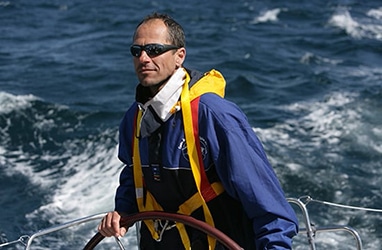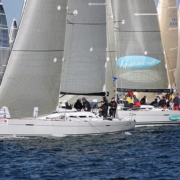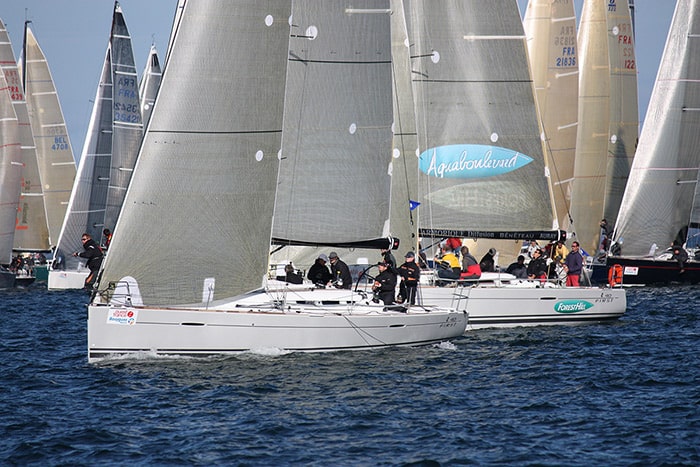Sails
Sails are sophisticated objects. It is not only the materials they are made from that are important, but also, the way they are cut and sewn. They are made mostly from a wide variety of synthetic materials, primarily Dacron, which is a homogeneous material that has the same strength in all directions. However since stresses from the wind come from different points and angles on the sail, some sails are designed from more high-tech materials such as carbon and Kevlar fibers. These have uni-directional strength designed into them to provide strength at specific points and angles. This reduces stretch in the sail and helps maintain sail shape where it is critical. Critical as in winning the race.
Mastering sail design and sail handling is a lifelong learning experience that involves practice and knowledge, as well as intuition. Adjusting sails while trying to anticipate wind shifts is fun indeed.
Because That’s WhyIn a race in Auckland Habour on a Beneteau First 45, I asked our highly paid professional racer sail trimmer to explain exactly why he gave the mainsail a half turn on the winch since everything looked fine and trimmed to me. His answer—“Because I felt it needed it.” I guess that is why he is paid a lot of money for his job. |
Every sail on a vessel represents a compromise involving the kind of winds the vessel will encounter, the vessel’s displacement, racing or cruising configuration, and finally, and perhaps most importantly, the depth of the owner’s pockets. Most sailors are initially quite content with the basic main and headsails provided by the manufacturer, but to win races, a deep pocket is required.
A Sailing Regatta
Sail Nomenclature
The following illustration shows the parts of the sail and associated control lines. Of note is the bolt rope, which is one of the very few actual ropes on a boat. (Remember the other two? Bell rope and bucket rope.)
- The bolt rope is usually sewn into the luff (leading edge) of the sail. It provides strength to the luff of the sail and is used also to slide into the track if there is one. On a head sail, the bolt rope provides strength to the luff of the sail when “hanks” are used.
- Hanks are basically sliding clamps that slide up the forestay and are clamped onto the bolt rope at the leading edge (luff).
- The main halyard is attached to the head of the sail and is used to pull the sail up the mast.
- The gooseneck is a swivel connection from the boom to the mast.
- The reefing points are points where the sail can be pulled down in order to reef the sail if a roller furling system is not used.
- The topping lift holds the back of the boom up.
- The boom vang holds the boom down when beating to wind. On downwind legs, the boom vang can be loosened to provide more shape to the sail.
- The cunningham pulls the sail down tight and is used also when reefing.
- The outhaul line is attached to the clew to pull the sail out along the boom.
Click on a letter to show the part name: click again to hide the part name. Then test yourself.
Names of Sail Thingies
Types of Sails
Headsails:
These are genoas and jib sails attached to the forestay. Genoas are by definition large enough whereby and the clew (bottom aft point of the sail) extends back behind the mast. A jib is smaller whereby the clew does not reach behind the mast.
Mainsails:
These sails are large and attached to the mast and boom. They fly behind the mast. These sails generally provide the primary propulsion force.
Most likely, initially, you will be dealing with a headsail and a mainsail. The interactive image below shows both typical sails on a sailboat, the Mainsail and the Jib (aka headsail). The image also shows the attachment points the head, tack, and clew for each of the sails. Tap on the letters to reveal the name – tap again to hide. Test yourself on what you can remember!
Spinnaker and Gennaker:
Additional commonly used sails are the spinnaker and gennaker. These are the classic gorgeous colorful sails you see used for capturing air to push the boat in downwind directions.
Furling Headsail
Furling headsails are more common than not these days. They unfurl (unroll) and furl (roll-up) around the headstay in a matter of seconds. They provide ease of sailing for cruisers because there is no need to go up on the foredeck to bring the sail down or raise the sail. There is also no need to change to a small sail size when encountering higher wind conditions because the roller furling sail can simply be rolled up incrementally to reef the sail (make the sail smaller). Some efficiency is lost because furling sails lack the battens that provide shape to the sail, making it more like the shape of an efficient airfoil. Some sailmakers have provided vertical battens for roller furling systems. This helps some with efficiency although not 100 percent. Still, the trade-off in ease of handling versus loss in efficiency is an obvious choice for most. Unless you want to win races, the roller furling headsail is a good choice and the cost of installing such a system is also inexpensive.
Below is a video by Harken who manufactures roller furling systems. It’s about 5 minutes long and is a good introduction to using a headsail roller furling system.
Harken Video
Here is another headsail furling video by Profurl who also builds furling systems. This is a more technical explanation of the components of a furling system.
Profurl Video
Sail Trim
Sail trim is the essence of being a sailor. It involves understanding fundamental physics to make judgments about the conditions in which you are sailing. This topic is never exhausted and is often the source of warm to heated discussions.
Contrary to the thought that the wind pushes the sails, sails actually provide “lift.” If this were not the case, how could the wind push the boat in upwind directions? When a sail is providing lift, the windward side of the sail has a higher pressure than the leeward side. This difference in pressure is the force that propels the sailboat. This is the same aerodynamic force that keeps a plane flying using its wings.
Trimming sails for maximum lift is a sailor’s primary challenge. This trimming is done using lines called sheets (jib and main) and these lines are often tensioned using winches, manual and/or electric.
As the sailboat turns to a more downwind angle, the sails begin to be pushed by the wind while also maintaining some lift. The overall object of trimming the sails is to understand and optimize the lift and push forces on the vessel. Good sail trim balance results from constantly being aware of wind flow over the sail and then making prudent adjustments to sails.
The Free Basic Sail Trim Course in your curriculum discusses sail trim in detail.








